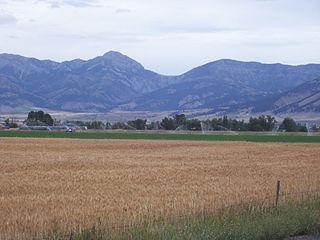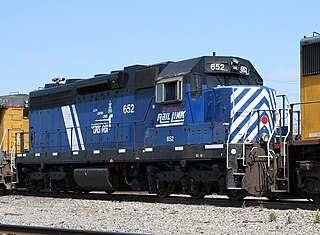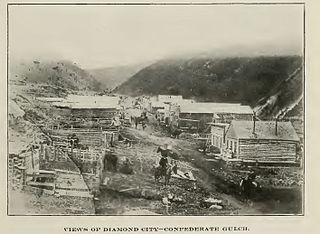
Big Sky is a census-designated place (CDP) in Gallatin and Madison counties in southwestern Montana. As of the 2010 census it had a population of 2,308. It is 45 miles (72 km) southwest of Bozeman. This unincorporated community straddles both counties, is not considered a town, and does not have a town government. The primary industry of the area is tourism.

The Bridger Range, also known as the Bridger Mountains, is a subrange of the Rocky Mountains in southwestern Montana in the United States. The range runs mostly in a north–south direction between Bozeman and Maudlow. It is separated from the Gallatin Range to the south by Bozeman Pass; from the Horseshoe Hills to the west by Dry Creek; from the Crazy Mountains to the east by the Shields River valley; and from the Big Belt Mountains to the north by Sixteen Mile Creek. The highest point in the Bridger Range is Sacagawea Peak, which is visible to the northeast from Bozeman.

John Merin Bozeman was a pioneer and frontiersman in the American West who helped establish the Bozeman Trail through Wyoming Territory into the gold fields of southwestern Montana Territory in the early 1860s. He helped found the city of Bozeman, Montana in 1864, which is named for him.

Montana Rail Link is a privately held Class II railroad in the United States. MRL, which operates on trackage originally built by the Northern Pacific Railway, is a unit of The Washington Companies, and is headquartered in Missoula, Montana.

Founded in 1899, Gallatin National Forest is located in south central Montana, United States. The forest comprises 1,819,515 acres (7,363.32 km2) and has portions of both the Absaroka-Beartooth and Lee Metcalf Wilderness areas within its boundaries. Gallatin National Forest borders Yellowstone National Park on the north and northwest and is part of the Greater Yellowstone Ecosystem, a region which encompasses almost 20,000,000 acres (81,000 km2). The forest is named after Albert Gallatin (1761–1849), U.S. Secretary of the Treasury and scholar of Native American languages and cultures.

Custer National Forest is located primarily in the south central part of the U.S. state of Montana but also has separate sections in northwestern South Dakota. With a total area of 1,188,130 acres (4,808 km2), the forest comprises over 10 separate sections. While in the westernmost sections, Custer National Forest is a part of the Greater Yellowstone Ecosystem, the easternmost sections are a combination of forest "islands" and grasslands. A portion of the forest is also part of the Absaroka-Beartooth Wilderness and constitutes over a third of the wilderness land. South of Red Lodge, Montana, the Beartooth Highway passes through the forest en route to Yellowstone National Park.

Lewis and Clark Caverns State Park is located in Jefferson County, Montana. The park includes two visitor centers, ten miles of hiking trails, a campground and its namesake limestone cavern.

The Cook–Folsom–Peterson Expedition of 1869 was the first organized expedition to explore the region that became Yellowstone National Park. The privately financed expedition was carried out by David E. Folsom, Charles W. Cook and William Peterson of Diamond City, Montana, a gold camp in the Confederate Gulch area of the Big Belt Mountains east of Helena, Montana. The journals kept by Cook and Folsom, as well as their personal accounts to friends were of significant inspirational value to spur the organization of the Washburn-Langford-Doane Expedition which visited Yellowstone in 1870.

Fort C. F. Smith was a military post established in the Powder River country by the United States Army in Montana Territory on August 12, 1866, during Red Cloud's War. Established by order of Col. Henry B. Carrington, it was one of five forts proposed to protect the Bozeman Trail against the Oglala Lakota (Sioux), who saw the trail as a violation of the 1851 Treaty of Fort Laramie. The fort was abandoned in 1868 and burned by the Sioux under Red Cloud.

The Gallatin Range is a mountain range of the Rocky Mountains, located in the U.S. states of Montana and Wyoming. It includes more than 10 mountains over 10,000 feet (3,000 m). The highest peak in the range is Electric Peak at 10,969 feet (3,343 m).
Interstate 90 (I-90) is an east–west transcontinental Interstate highway across the northern United States, linking Seattle to Boston. The portion in the state of Montana is 554.10 miles (891.74 km) in length, passing through fourteen counties in central and southern Montana.
The Bridger Trail, also known as the Bridger Road and Bridger Immigrant Road, was an overland route connecting the Oregon Trail to the gold fields of Montana. Gold was discovered in Virginia City, Montana in 1863, prompting settlers and prospectors to find a trail to travel from central Wyoming to Montana. In 1863, John Bozeman and John Jacobs scouted the Bozeman Trail, which was a direct route to the Montana gold fields through the Powder River Country. At the time the region was controlled by the Sioux, Cheyenne and Arapaho, who stepped up their raids in response to the stream of settlers along the trail.

Nelson Story Sr. was a pioneer Montana entrepreneur, cattle rancher, miner and vigilante, who was a notable resident of Bozeman, Montana. He was best known for his 1866 cattle drive from Texas with approximately 1000 head of Texas Longhorns to Montana along the Bozeman Trail—the first major cattle drive from Texas into Montana. His business ventures in Bozeman were so successful that he became the town's first millionaire. In 1893, he played a prominent role in the establishment of the Agricultural College of the State of Montana by donating land and facilities. He built the first Story Mansion on Main Street in Bozeman in 1880 and later built today's Story Mansion at the corner of Willson and College for his son, T. Byron Story in 1910. In his later years, he became a prominent real estate developer in Los Angeles, California.
The Lewis and Clark Marathon is an annual Bozeman, Montana event in Late May or Early June. Self-proclaimed to be "The first marathon in the west", the race is built on Lewis & Clark's Corps of Discovery Expedition in 1806. The race is said to follow in the footsteps of the pioneers over a challenging marathon course of trails, paved and gravel roads complete with dramatic views of four mountain ranges, fresh air and wide open spaces. A significant portion of Lewis and Clarks journey was spent in Montana including a portion in Bozeman, a college town surrounded by the Gallatin National Forest and 90 miles from Yellowstone National Park. Situated at 4,793 ft above sea level.
Camp Cooke also known as Fort Claggett as a U.S. Army military post on the Missouri River in Montana Territory. The camp was established on July 10, 1866, just upstream from the mouth of the Judith River by the 13th Infantry Regiment. By 1867 Camp Cooke had a strength of approximately 400 men. The army established the post to protect steamboat traffic en route to Fort Benton. The boats carried passengers and freight to supply swiftly growing boom towns at the site of rich gold strikes in the western mountains of the Montana Territory.

Transportation in Montana comprises many different forms of travel. Montana shares a long border with Canada, hence international crossings are prevalent in the northern section of the state; there are 13 road crossings and one rail crossing.

Kate P. Calvin was the only woman among Montana State College's first three professors and the first music professor.















